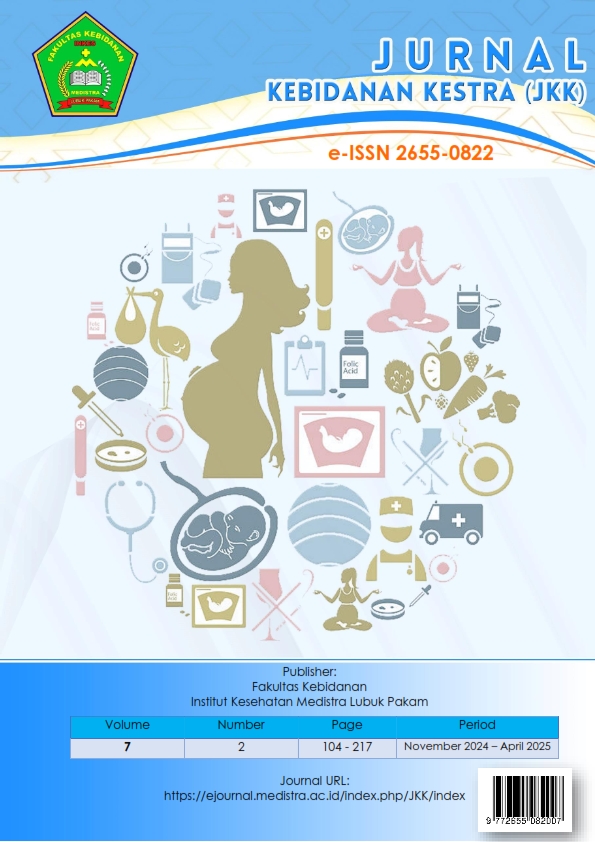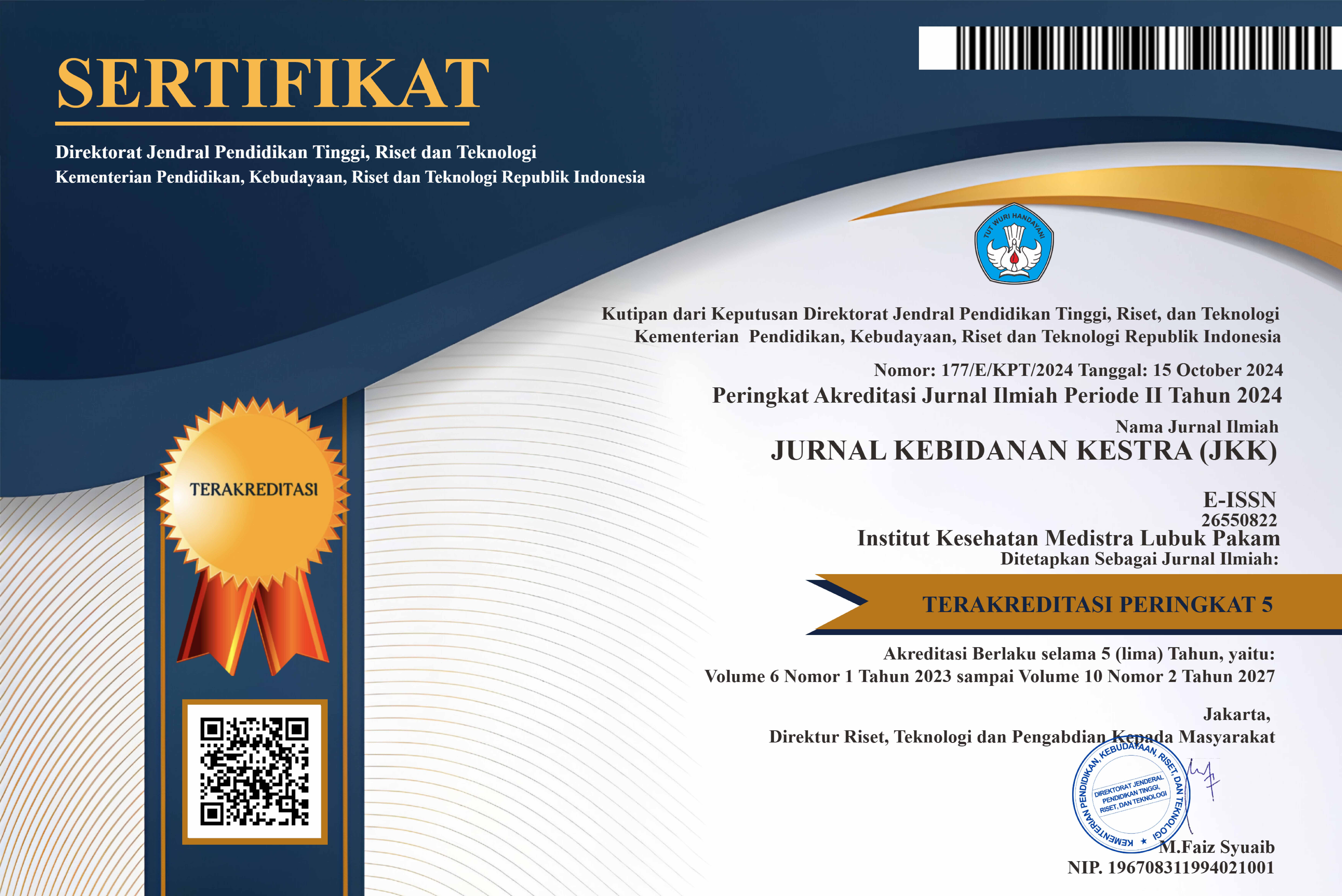The Effect of Using Contraceptives on The Nutritional Status of Woman of Childbearing Age
DOI:
https://doi.org/10.35451/jkk.v7i2.2463Keywords:
Use of contaception, Nutritional statusAbstract
Nutritional status during this period, especially in women of childbearing age, is influenced by several things, including the use of contraceptives. Side effects of using contraception include excess weight gain which can cause various diseases. Meanwhile, long-term impacts for families who do not use contraception can be in the form of increasing population, food and nutrition shortages, low education, lack of job opportunities, high birth and death rates. The aim of this study was to analyze the effect of contraceptive use on nutritional status in women of childbearing age. This research is an analytical observational study with a cross sectional design. The research sample consisted of 225 respondents using Eta Squared test data analysis. The results of the study show that contraceptive use has a positive and significant effect on nutritional status (p = 0.24), which means that the hypothesis is accepted if F count > F table (p = 0.05) at a certain probability. Suggestions for future researchers are to pay attention to other factors so that the nutritional status of women of childbearing age remains normal even though they use contraception
Downloads
References
BPS. Jumlah Penduduk Indonesia 2024 [Internet]. 2024. Available from: https://www.bps.go.id/id/statistics-table/2/MTk3NSMy/jumlah-penduduk-pertengahan-tahun--ribu-jiwa-.html
Kementerian P. Pedoman Teknis Penyusunan Rencana Aksi - Edisi II Tujuan Pembangunan Berkelanjutan/ Sustainable Development Goals (TPB/SDGs). Kementeri PPN. 2020;1–23.
BPS. Persentase Wanita Berumur 15-49 Tahun dan Berstatus Kawin yang Sedang Menggunakan/Memakai Alat KB (Persen), 2024 [Internet]. 2024. Available from: https://www.bps.go.id/id/statistics-table/2/MjE4IzI=/persentase-wanita-berumur-15-49-tahun-dan-berstatus-kawin-yang-sedang-menggunakan-memakai-alat-kb.html
Syafar M, Azis R, Taurisa A. Faktor Yang Mempengaruhi Penggunaan Kontrasepsi IUD ( Intra Uterine Device ) Di Puskesmas Tinggede Irma2610197@gmail.com. Bina Gener?; J Kesehat. 2024;(1):23–35.
Cwiak C. Contraception for high risk patients. Semin Perinatol [Internet]. 2020;44(5):151268. Available from: https://doi.org/10.1016/j.semperi.2020.151268
Suriawatina DB, Indrawati V. Pengaruh Pola Makan dan Aktivitas Fisik Terhadap Status Gizi Lebih pada Wanita Usia Subur (WUS) di Wilayah Kerja Puskesmas Kauman Ponorogo. Med Res Public Heal Inf J. 2024;1(2):28–40.
Sirait LI, Sidharta JS, Telaumbanua LK. Peningkatan Berat Badan pada Akseptor KB Pengguna Kontrasepsi Suntik. UMP Press. 2025;7:61–9.
Feriani P, Yunitasari E, Efendi F, Krisnana I, Ernawati R, Tianingrum NA, et al. A Systematic Review of Determinants Influencing Family Planning and Contraceptive Use. Iran J Nurs Midwifery Res. 2024;29(5):596–607.
Bornstein M, Huber-Krum S, Kaloga M, Norris A. Messages around contraceptive use and implications in rural Malawi. Cult Heal Sex [Internet]. 2021;23(8):1126–41. Available from: https://doi.org/10.1080/13691058.2020.1764625
Sherli Deviana, Widya Mariyana, Rinda Intan Sari. Hubungan Tingkat Pendidikan, Pekerjaan Dan Dukungan Keluarga Terhadap Pemilihan Metode Kontrasepsi Jangka Panjang Pada Wanita Usia Subur Di Klinik Bpjs Irma Solikin Mranggen Demak. Detect J Inov Ris Ilmu Kesehat. 2023;1(1):210–26.
Connor B, Jan Arif. BMI Classification Percentile And Cut Off Points [Internet]. StatPearls Publishing LLC; 2023. Available from: https://www.ncbi.nlm.nih.gov/books/NBK541070/
Aulia Rizky Ramadhania, Azwaj Nailla Hasna, Rieke Kartika Winata, Heri Ridwan, Popi Sopiah. Hubungan Aktivitas Fisik dan Pola Makan terhadap Status Indeks Masa Tubuh Normal. Sehatmas J Ilm Kesehat Masy. 2024;3(1):58–66.
Kemenkes RI. Survei Kesehatan Indonesia (SKI) Dalam Angka. Kota Kediri Dalam Angka. 2023;1–68.
Wafaa Ali Belail Hammad, Neerja Gupta JCK. An overview of contraception in women with obesity. Best Pract Res Clin Obstet Gynaecol [Internet]. 2023;91. Available from: https://www.sciencedirect.com/science/article/abs/pii/S1521693423001165
Kamila E, Wildan M, Dzulhijjah DF. Perbedaan Pengaruh Lama Pemakaian Kontrasepsi Pil Kombinasi Dengan Dmpa Terhadap Peningkatan Indeks Massa Tubuh Pendahuluan Program Keluarga Berencana ( KB ) merupakan bagian upaya penanggulangan ledakan penduduk dunia umumnya dan punduduk Pemerintah Indo. J Kebidanan. 2021;10(77).
Izhar MD. Determinan Kejadian Overweight pada Wanita Usia Subur di Kota Jambi. J Ilm Univ Batanghari Jambi. 2020;20(2):410.
Silvia Fransina Sopacua, Kamidah Kamidah. Hubungan Lamanya Pemakaian KB Implant dengan Kenaikan Berat Badan di Wilayah Kerja Puskesmas Taniwel. J Gen Heal Pharm Sci Res. 2024;2(3):42–55.
Lazorwitza A, Sheedera J, Teal S. Variability in repeat serum etonogestrel concentrations among contraceptive implant users during the steady-release pharmacokinetic period. Contraception [Internet]. 2022;108:65–8. Available from: https://www.contraceptionjournal.org/article/S0010-7824(21)00463-7/abstract
Goto D, Grunden JW, Klinghardt M, Patel VP, Von Stockum S, Barnett C, et al. Effectiveness of the etonogestrel subdermal implant in users with overweight and obesity: a systematic literature review. BMJ Sex Reprod Heal. 2024;1–9.
Pawiyarni P. Hubungan Lama Penggunaan, Status Gizi, Aktifitas Fisik Dengan Gangguan Siklus Menstruasi Pada Akseptor KB Suntik 1 Bulan. Simfisis J Kebidanan Indones. 2022;2(1):253–8.
Ilmiya I, Sulistiyawati I. Analysis of Husband Support, Family, Friends dan Health Workers to The Use of MKJP in Women of Reproductive Age. J Kebidanan Kestra. 2022;5(1):123–8.
Eko NW. Kesehatan Reproduksi dan Keluarga [Internet]. Vol. 11, Sustainability (Switzerland). Bandung: CV. Media Sains Indonesia; 2020. 1–14 p. Available from: http://scioteca.caf.com/bitstream/handle/123456789/1091/RED2017-Eng-8ene.pdf?sequence=12&isAllowed=y%0Ahttp://dx.doi.org/10.1016/j.regsciurbeco.2008.06.005%0Ahttps://www.researchgate.net/publication/305320484_Sistem_Pembetungan_Terpusat_Strategi_Melestari
Downloads
Published
Issue
Section
License
Copyright (c) 2025 Istifadatul Ilmiya

This work is licensed under a Creative Commons Attribution 4.0 International License.
Copyright in each article is the property of the Author.



























